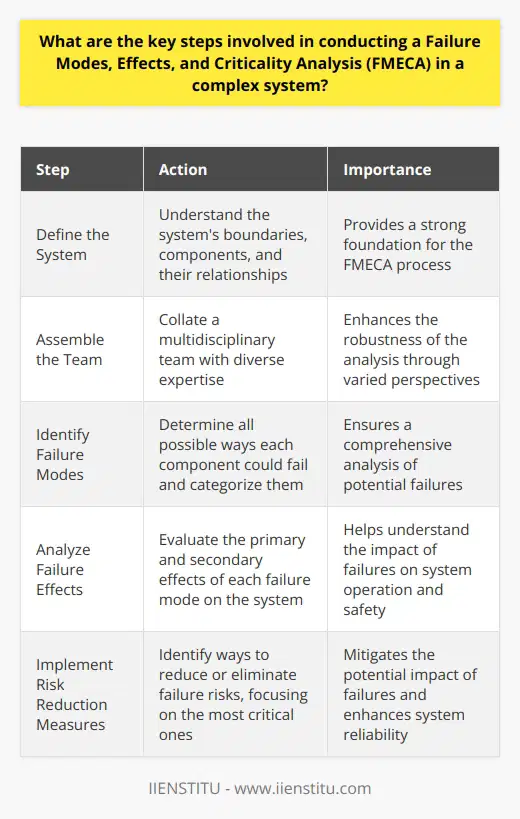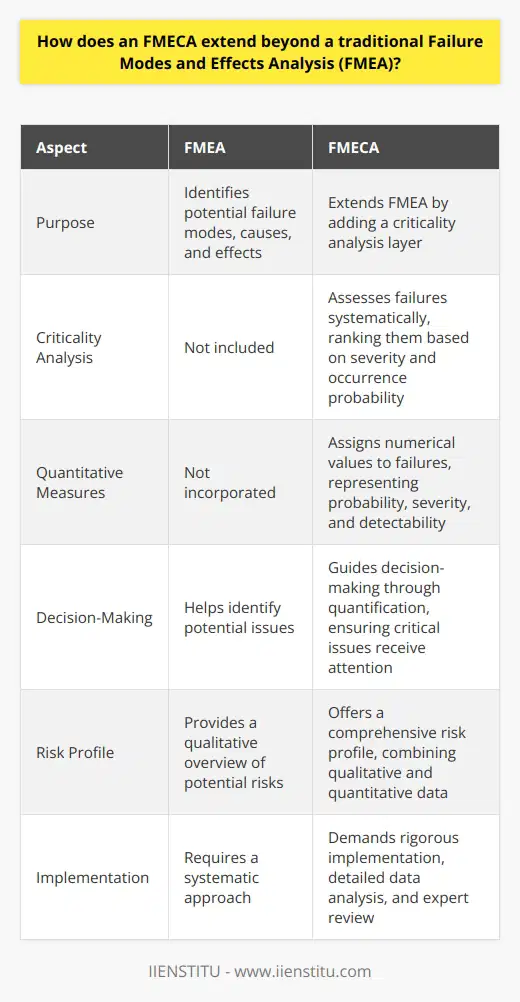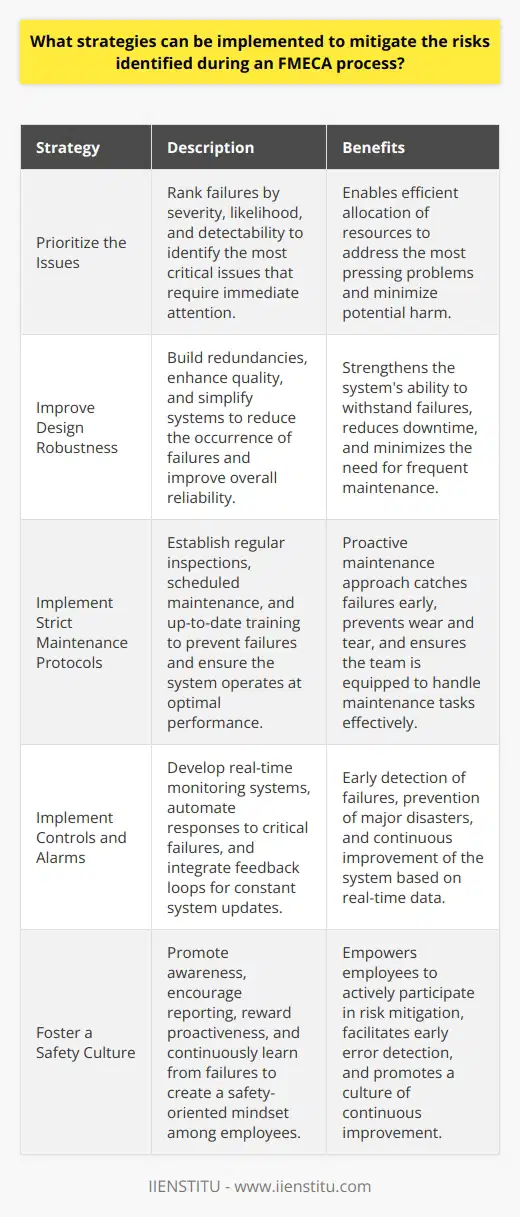
Failure Modes, Effects, and Criticality Analysis (FMECA) is an indispensable tool in the arsenal of any organization looking to bolster their reliability and ensure the efficiency of their operations. This analytical methodology is particularly crucial in industries where the cost of failure is not just financial but could potentially result in environmental disaster, loss of life, or catastrophic system failures. The rigorous assessment that FMECA enables, provides an intricate understanding of the potential points of failure within a system and the consequential impact of those failures, allowing for a prioritized approach to mitigation that is both strategic and informed.
Define the Concept of FMECA
FMECA is a systematic process deconstructed into three primary components – the identification of failure modes, the effects arising from such failures, and the criticality, which prioritizes the significance of these failures based on their impact on the entire system. Its application spans across a variety of sectors, including aerospace, automotive, manufacturing, and healthcare, amongst others. In practice, FMECA guides engineers and technicians in enhancing system reliability and safety, which leads to increased performance and reduced downtime.
Understanding Failure Modes, Effects, and Criticality Analysis (FMECA)
Explaining Failure Modes
Definition and Significance
At the core of FMECA lies the definition of failure modes – the ways, or modes, in which something might fail. Failures are classified according to their impact on the overall operation, and understanding these modes is the first step in implementing preventative measures. The process of identifying different failure modes is fundamental to developing a robust troubleshooting strategy that ensures continued functionality and reliability.
Case Example to Understand Failure Modes
An illustrative case example can deepen one's comprehension of failure modes. For instance, in an automotive engine, failure modes may include overheating, lubrication failure, or combustion problems. Each of these will affect the engine's performance differently, and understanding these specific modes allows for targeted preventative maintenance.
Understanding Effects
Failure Tree Analysis: Effective Approach for Risk Assessment
Total Productive Maintenance (TPM): A Comprehensive Guide to Improved Efficiency
How Effects Impact Operations
Once the failure modes are determined, assessing their effects is the next critical step. The effects of failures refer to the immediate and subsequent outcomes that these failures can have on system operation, personnel safety, and the environment. It is a detailed examination of consequences that result from each failure mode, necessitating a clear understanding of system operations.
Real-world Example of Effects in Operational Infrastructures
Taking the example of an industrial boiler system, should a failure occur due to corrosion, the effect could be a rupture, leading to operational stoppage. The repercussions extend beyond immediate downtime, potentially causing environmental harm due to the escape of harmful gases or even posing a risk to worker safety.
Delving into Criticality Analysis
What is Criticality Analysis and Why is it Essential
Criticality analysis is the portion of FMECA that assesses the likelihood of failure occurrence and the severity of its effects. It answers the question of which failure modes demand the highest attention based on their critical impact. This step is essential for prioritizing resources and attention in risk management and maintenance planning.
Case Example to Explain the Impact of Criticality Analysis
Consider a pharmaceutical company that utilizes a large number of complex machines in its production line. An FMECA may reveal that a failure in the sterility unit has both a high likelihood of occurrence and dire consequences for product safety. Criticality analysis would then prioritize this failure mode high on the risk management agenda to ensure product integrity and public safety.
The Process of Conducting FMECA
Step-by-step Procedure of FMECA
Expert Guide On Statistical Analysis For Strategic Decision Making
Multi-criteria Decision Analysis İş Stratejileri İçin Nasıl Uygulanır
Identifying Failure Modes
The procedure of FMECA starts with a thorough identification of every conceivable failure mode within a system. This involves a meticulous examination of components and their relationships, guided by historical data, engineering expertise, and sometimes, predictive analytics.
Evaluating and Assigning Severity Rating to Effects
Once identified, the next step is to evaluate the severity of the effects of each failure mode. Severity ratings are assigned on a scale, with guidelines customized to the specific context of the operation, which assists in the subsequent criticality analysis.
Implementing Criticality Analysis
Criticality analysis involves the use of a risk matrix or similar tool to combine the likelihood of failure occurrence with the severity rating of its effect. This analysis results in a prioritized list of failure modes to address with risk mitigation measures.
Significance of Each Step Using Practical Examples
To truly understand the significance of each step in FMECA, consider the case of an airline conducting this analysis to ensure the safety and reliability of its fleet. Identifying failure modes could involve potential mechanical and electronic faults, assigning severity ratings to their effects might include evaluating potential for system failure or flight diversion, and criticality analysis would determine the prioritization of maintenance and inspections.
Benefits of Implementing FMECA
Ensuring Operational Safety and Efficiency
The overarching benefit of FMECA is the assurance of safety and efficiency in operations. By identifying critical failure modes and understanding their effects, companies can design systems and protocols that significantly reduce the risk of catastrophic failures.
Identifying and Reducing Risks
FMECA is an invaluable tool in risk management, providing a clear blueprint for identifying weaknesses within a system. Through its methodical approach, FMECA helps prevent unexpected downtime and promotes proactive problem-solving in day-to-day operations.
Case Study of Effective FMECA Implementation
A compelling case study supporting the benefits of FMECA comes from the chemical processing industry. Here, implementation of FMECA has enabled companies to identify potential equipment failures that could lead to hazardous material leaks or process disruptions, allowing for preemptive measures that have saved resources and maintained regulatory compliance.
Challenges in Applying FMECA and How to Overcome Them
Complexities in the Process
Despite its numerous benefits, FMECA inherently presents complexities in its implementation. The analysis requires a depth of knowledge about the system being examined, as well as a structured approach to data management and assessment.
Misinterpretation of Results
The results of FMECA can be misinterpreted when there is an inadequate understanding of the system's intricacies or improper handling of the process. It requires a certain level of expertise to interpret the findings correctly and make informed decisions.
Strategies and Measures to Mitigate these Challenges
To mitigate these challenges, organizations may utilize cross-functional teams to bring diverse expertise to the process, invest in problem solving skills course for technical staff, and consider online certificate courses to enhance the skill sets of those involved in conducting FMECA.
Recap of FMECA Importance and Application
FMECA remains a critical component in ensuring industrial systems' reliability, safety, and efficiency. By systematically breaking down and analyzing every possible failure mode, its effect, and the associated criticality, companies can pre-empt potential issues and implement predictive maintenance strategies.
Emphasizing the Need for Regular FMECA in Industrial Operations
It is vital for industries to recognize the need for regular implementation of FMECA to stay ahead of system failures, maintain operational excellence, and uphold safety standards. The process, when executed correctly, is not merely a form of analysis but an actionable guide towards sustainable and reliable operations.
Frequently Asked Questions
What are the key steps involved in conducting a Failure Modes, Effects, and Criticality Analysis (FMECA) in a complex system?
Understanding FMECA
Failure Modes, Effects, and Criticality Analysis (FMECA) is a methodical approach. It assesses potential failures in a system. Analysts aim to identify the impact of different types of failures. Then prioritize them by severity and likelihood. Companies often use FMECA to enhance reliability and safety. It focuses on discovering and mitigating risks.
Step 1: Define the System
Start with a complete system definition. Understand the system's boundaries. Identify its components. Map out their relationships. Recognize the intended function of each element. Without this clarity, FMECA lacks a strong foundation.
Step 2: Assemble the Team
Collate a multidisciplinary team. The team needs members with diverse expertise. They bring varied perspectives on system operations. Thus, they enhance the robustness of the analysis.
Step 3: Identify Failure Modes
Determine all possible ways each component could fail. Think broadly. Consider all potential failure modes. Categorize them for better analysis if needed.
Step 4: Analyze Failure Effects
For each failure mode, evaluate its effects. Start with primary effects on the component itself. Move to secondary effects on the entire system. Understand how these failures impact the system operation or safety.
Step 5: Assign Criticality Levels
Rank each failure mode based on its severity. Use criticality levels. They help prioritize the failures. High criticality means high priority for mitigation efforts.
Step 6: Calculate Likelihood
Estimate the probability of each failure occurring. Use historical data if available. Otherwise, rely on expert judgment. This likelihood helps determine where to focus resources.
Step 7: Develop a Risk Matrix
Combine criticality and likelihood in a risk matrix. This matrix visualizes where the greatest risks lie. It guides decision-making for addressing failures.
Step 8: Implement Risk Reduction Measures
Identify ways to reduce or eliminate failure risks. Develop procedures or design changes as needed. Focus on the most critical risks first.
Step 9: Document Results and Decisions
Record the analysis and the rationale for decisions. Document all mitigation measures planned or implemented. Maintain this documentation for accountability and future reference.
Step 10: Review and Update Regularly
FMECA is not a one-time task. Regular reviews are essential. Systems and risks evolve over time. Update the FMECA to reflect these changes.
By following these steps, organizations can effectively conduct FMECA. The goal is not to eliminate all risks. It is about managing them effectively. Through FMECA, the aim is to increase system reliability and safety. This systematic approach can help prevent catastrophic failures. It ensures that systems perform as required throughout their life cycle.

How does an FMECA extend beyond a traditional Failure Modes and Effects Analysis (FMEA)?
Understanding FMEA and FMECA
Failure Modes and Effects Analysis (FMEA) maps out potential failures. It identifies their effects. Engineers and manufacturers utilize this technique. It helps in enhancing reliability and safety. FMEA looks at possible failure modes. It considers their causes and effects.
Extending into FMECA
Failure Mode, Effects, and Criticality Analysis (FMECA) goes further. It extends the FMEA process. It adds a criticality analysis layer. This quantifies the severity and likelihood. It evaluates the impact of each failure mode.
Criticality Analysis
Criticality analysis focuses on each failure's consequences. It assesses failures systematically. It ranks them based on severity and occurrence probability. This step prioritizes issues for corrective actions. It supports decision-making and risk mitigation.
Quantitative Measures
FMECA incorporates quantitative measures. It assigns numerical values to failures. Values represent probability, severity, and detectability. These acts provide a more structured approach. They enable the determination of the risk priority number (RPN).
Enhanced Decision-Making
Through quantification, FMECA guides decision-making. It helps to allocate resources effectively. It ensures critical issues receive attention. This prioritization is data-driven. It focuses on reducing high-risk failures.
FMECA Creates a Comprehensive Risk Profile
FMECA offers a detailed risk profile. It helps mitigate risks before they occur. It combines both qualitative and quantitative data. This dual approach gives a full picture.
Implementation Rigor
FMECA demands rigorous implementation. It needs detailed data analysis. Experts must review each step. They assure its accuracy. This adds depth to the analysis.
Summary
In essence, FMECA broadens FMEA's scope. It introduces criticality and numerical analysis. It distinguishes degrees of importance among potential failures. FMECA aids in the more detailed prioritization. It incorporates a proactive approach to risk management. This comprehensive method aids in creating more robust, reliable products.

What strategies can be implemented to mitigate the risks identified during an FMECA process?
Introduction to FMECA Mitigation Strategies
Failure Modes, Effects, and Criticality Analysis (FMECA) identifies potential product or process failures. This preventive action serves industries well. It targets reliability and safety. Once we spot risks, we must manage them. Effective strategies make workplaces safer. They also improve systems. Let's explore these strategies now.
Prioritize the Issues
Rank Failures by Severity
Firstly, assess the impact. Use criticality scores wisely. Rank failures by potential harm. Focus on top-scoring issues. They deserve immediate attention.
Sort by Likelihood
Secondly, consider occurrence rates. Address common failures swiftly. Less frequent issues may wait.
Evaluate Detectability
Thirdly, think about detection. Can you spot the failure early? Improve the odds here.
Improve Design Robustness
Build Redundancies
Strengthen your systems. Add backup components. Ensure they take over smoothly.
Enhance Quality
Higher quality reduces failures. Select better materials. Apply refined processes accordingly.
Simplify Systems
Complex designs fail more. Simplify where possible. Streamline for better reliability.
Strict Maintenance Protocols
Regular Inspections
Inspect often. Catch failures early. Prevent bigger problems efficiently.
Scheduled Maintenance
Maintain regularly. Follow a strict schedule. Prevent wear and tear.
Up-to-Date Training
Train continually. Ensure team skillfulness. They must handle maintenance tasks well.
Implement Controls and Alarms
Create Monitoring Systems
Develop real-time monitors. Alerts should come before major failures.
Automate Responses
Consider automatic shutdowns. Use them for critical failures. They can prevent disasters.
Feedback Loops
Feedback improves systems. Integrate it for constant updates. Adjust accordingly.
Foster a Safety Culture
Promote Awareness
Education is key. Knowledge empowers employees. Keep them informed always.
Encourage Reporting
Make reporting easy. Errors spotted early can save much.
Reward Proactiveness
Incentivize good practices. Recognize employees that avert risks.
Continuous Improvement
Learn from Failures
Document each failure. Analyze them deeply. Adapt to new insights.
Audit the FMECA Process
Review FMECA regularly. Look for missed risks. Update your analyses.
Innovate Constantly
Aim for better solutions. Embrace new technologies. They can revolutionize safety.
Conclusion
In conclusion, FMECA outlines the map. Strategies are the vehicle. Drive improvements with them. Enhance reliability effectively. Boost safety for all. Each step you take builds a more resilient future. Remember, prevention beats correction. Always.



